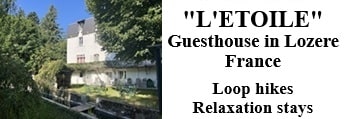Through this desolate site flowed the Allier and a tributary of almost equal volume that came down to join it through a wide, bare valley of Vivarais. The weather had cleared a bit, and the clouds grouped in squadrons, but the fierce wind still pushed them around the sky, distributing immense disjointed splashes of shadow and light across the scene.
Luc itself consists of a double row of sparse houses squeezed between a mountain and a river. It offers to the eye neither beauty nor a single notable feature, except for the ancient castle that overlooks it with its fifty quintals of Madonna shining brightly. But the inn was clean and spacious. The kitchen, with its beautiful compartmented beds draped with neat canvas curtains; the immense stone fireplace, its mantle four meters long, adorned with lanterns and religious figurines, its array of chests and its two ticking clocks, formed the true model of what a kitchen should be - a melodramatic kitchen suitable for bandits and disguised gentlemen.
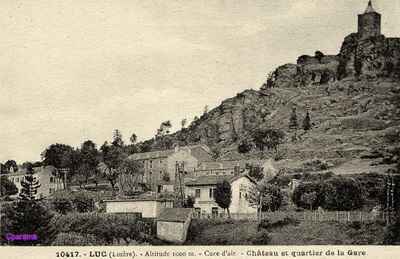
And the scene was not dishonored by the innkeeper, an old woman, a silent and dignified shadow, dressed in black like a nun. Even the common dormitory had its original character with its long tables and white wooden benches, where fifty guests could have dined, arranged as for a harvest festival, and its three compartmented beds along the wall. In one of them, lying on straw and covered by a pair of tablecloths, I spent a whole night in penance, my body goosebumped and my teeth chattering. And I sighed from time to time when I awakened, after my sheepskin sack and the edge of some great wood under the wind.
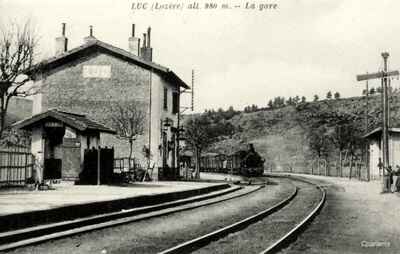
The next morning (Thursday, September 26) I set out with a new arrangement. The sack was no longer folded in two but suspended in its entirety from the saddle, a green sausage six feet long with a tuft of blue wool sticking out at one end or the other.
It was more picturesque, it spared the donkey and, as I soon noticed, ensured stability, whether it was windy or not. But it was not without apprehension that I resolved to do so. Although I had purchased a new rope for this purpose and arranged it as securely as I was able, I was still wary and anxious that the sides would detach and scatter my belongings along the route.
My route ascended the bare valley of the river along the borders of Vivarais and Gévaudan. The mountains of Gévaudan on the right were even more bare, if one can say so, than those of Vivarais on the left. The former had the privilege of stunted bushes that grew thick in the gorges and died in isolated bushes on the slopes and peaks. Dark rectangles of fir trees were scattered here and there on both sides.
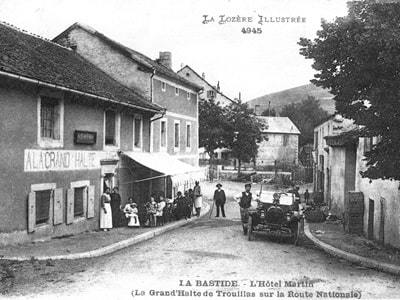
A railway ran parallel to the river. It is the only stretch of railway in Gévaudan, although there are several projects underway and topographic studies have been undertaken, and even, I have been assured, the location of a station ready to be built in Mende has been determined. One or two more years and it will be another world. The desert is besieged. From now on, a few Languedocians can translate into patois the sonnet of Wordsworth: “Mountains and valleys and torrents, do you hear that whistle?”
In a place called La Bastide, I was advised to leave the course of the river and follow a road that climbed to the left among the mountains of Vivarais, modern Ardèche. For I had now reached the little path leading to my strange destination: the Trappist convent Notre Dame des Neiges.
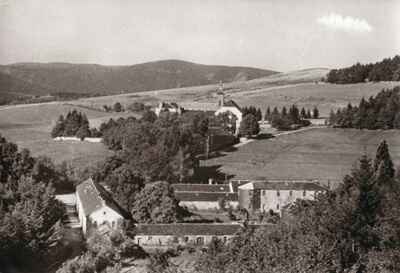
The sun appeared as I left the cover of a pine wood and suddenly I discovered a pretty wild site to the south. High rocky mountains, as blue as sapphire, closed the horizon. Between them, tier upon tier, were mountains covered with heather and rocks, the sun sparkling on the veins of the rocks, the thicket invading the ravines, as harsh as on the day of creation. There was no sign of human hand in the entire landscape and, in truth, no trace of its passage, except where one generation after another had walked along narrow winding paths penetrating beneath the birches and emerging, up and down the slopes they furrowed.
The mists, which had surrounded me until then, had now dissolved into clouds and were fleeing quickly, shining brightly in the sun. I breathed deeply. It was delightful to arrive, after so long, at a place of some charm for the human heart. I admit I love a specific shape where my gaze rests, and if landscapes were sold like the images of my childhood, a penny in black, and four sous in color, I would gladly give four sous every day of my life. But if the appearance of things had developed better to the south, it was still desolation and harshness just a stone's throw from me.

A tripod cross at the summit of each mountain indicated the proximity of a religious establishment. A quarter-mile beyond, the perspective to the south widened and became more pronounced step by step; a white statue of the Virgin at the edge of a young plantation directed the traveler toward Our Lady of the Snows. Here, I therefore turned left and continued on my way, leading my secular donkey in the creaking of my shoes and my lay gaiters, toward the asylum of silence. I had not progressed very far when the wind brought me the sound of a bell, and I hardly know how to say why, but my heart tightened in my chest at that sound.
I have rarely felt more sincere anxiety than when approaching this monastery Notre Dame des Neiges. Was it from having received a Protestant education? And suddenly, at a turn, a fear engulfed me from head to toe - superstitious fear, slave fear. Although I kept moving forward, I still continued slowly, like a man who has unwittingly crossed a border and is now in the land of the dead.
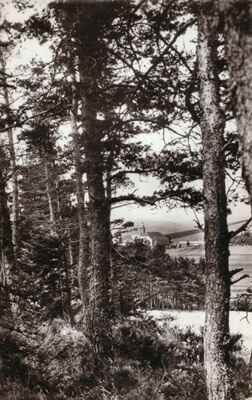
There, indeed, on a newly opened narrow road, among the young pines, there was a medieval monk struggling with a wheelbarrow of grass. Every Sunday of my childhood, I used to leaf through "The Hermits" by Marco Sadeler, fascinating engravings, filled with woods and fields and medieval landscapes as wide as a county for the wandering imagination! And there was undoubtedly one of Sadeler's heroes. He was wrapped in white like a ghost, and the hood, falling over his back in his effort to push the wheelbarrow, revealed a skull as bald and yellow as a death's head. He might have been buried some time a thousand years ago, and all the life particles of his being reduced to dust and broken by the contact of a farmer's harrow. Moreover, my mind was troubled by etiquette.
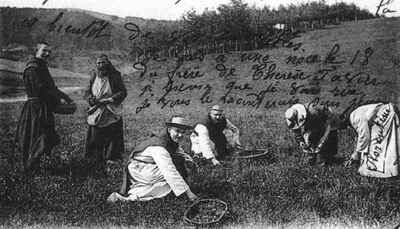
Should I speak to someone who had taken a vow of silence? Obviously not! However, as I approached, I removed my cap before him with a superstitious deference, rooted in the depths of centuries. He gave me a slight nod in return and cordially addressed me. Was I going to the convent? Who was I? An Englishman? Ah! An Irishman, then? - No, I said, a Scot. A Scot? Ah! he had never seen a Scot before. And he examined me from head to toe, his good honest face brightened with interest, like a child might look at a lion or a caiman.
From him, I learned with displeasure that I would not be received at Our Lady of the Snows. Perhaps I could have a meal there, but that was all. And then, as our conversation continued, and he discovered that I was not a peddler, but a man of letters who drew landscapes and intended to write a book, he changed his view regarding my reception (for I fear that we take regard for quality people even in a Trappist convent). He told me that I must ask the Father Prior and lay out my case without reserve.
Upon further reflection, he decided to descend with me himself. He thought he could arrange things better for me. Could he say I was a geographer? No. I thought, in the interest of truth, that he really could not. - Very well! then (with annoyance) an author?

 How one can feel the desire to visit Luc or Le Cheylard l'Évêque is beyond what my inventive mind can imagine. As for me, I travel not to go somewhere, but to walk. I travel for the pleasure of traveling. The important thing is to move, to experience more closely the necessities and troubles of life, to leave the cozy bed of civilization, to feel the earthly granite and the scattered flints cutting under my feet. Alas! As we advance in existence and become more preoccupied with our little egos, even a day off is a thing that requires effort. However, maintaining a load on a pack against a biting northern wind is not a quality activity, but it nonetheless contributes to occupying and shaping one's character. And when the present shows so many demands, who can care about the future?
How one can feel the desire to visit Luc or Le Cheylard l'Évêque is beyond what my inventive mind can imagine. As for me, I travel not to go somewhere, but to walk. I travel for the pleasure of traveling. The important thing is to move, to experience more closely the necessities and troubles of life, to leave the cozy bed of civilization, to feel the earthly granite and the scattered flints cutting under my feet. Alas! As we advance in existence and become more preoccupied with our little egos, even a day off is a thing that requires effort. However, maintaining a load on a pack against a biting northern wind is not a quality activity, but it nonetheless contributes to occupying and shaping one's character. And when the present shows so many demands, who can care about the future?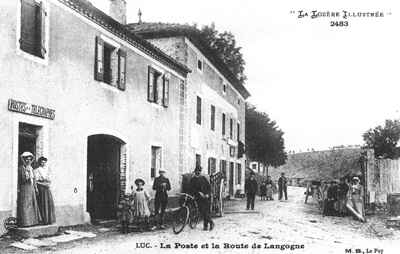 I finally emerged above the Allier. It would be difficult to imagine a less attractive perspective at this time of year. Sloping hills formed a closed circus alternating here with woods and fields, and there, rising peaks either bald or hairy with pines. The atmosphere was dark and ashy from one end to the other, and this color culminated at a point in the ruins of the castle of Luc that rose proudly beneath my feet, carrying atop its pinnacle an immense white statue of Our Lady. I learned with interest that it weighed fifty quintals and was to be consecrated on October 6.
I finally emerged above the Allier. It would be difficult to imagine a less attractive perspective at this time of year. Sloping hills formed a closed circus alternating here with woods and fields, and there, rising peaks either bald or hairy with pines. The atmosphere was dark and ashy from one end to the other, and this color culminated at a point in the ruins of the castle of Luc that rose proudly beneath my feet, carrying atop its pinnacle an immense white statue of Our Lady. I learned with interest that it weighed fifty quintals and was to be consecrated on October 6.






